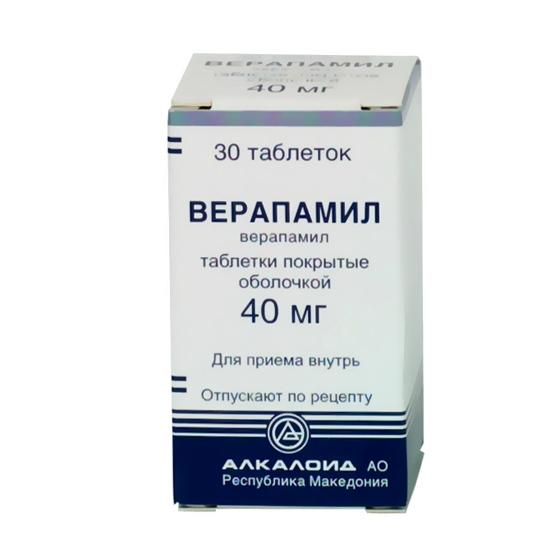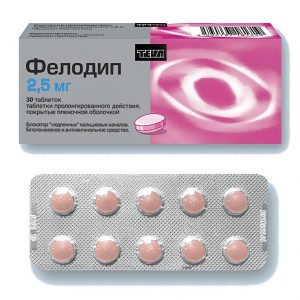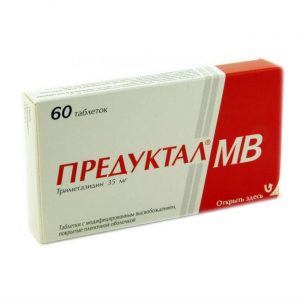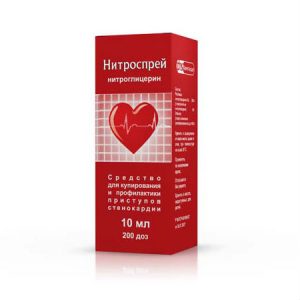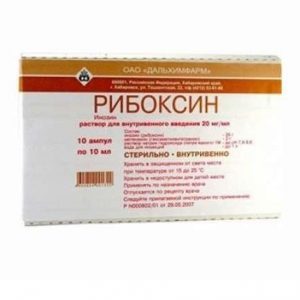Description
Release form
Tablets.
Packing
30 pcs.
Pharmacological action
Verapamil is a selective calcium channel blocker of class I. The main pharmacological properties of the drug are due to its ability to prevent the entry of calcium ions into cardiomyocytes and smooth muscle cells of the vascular wall through the slow calcium channels of the membrane. Verapamil has antiarrhythmic, antianginal and antihypertensive activity. Reduces myocardial oxygen demand by reducing myocardial contractility and lowering heart rate. It causes the expansion of the coronary arteries and an increase in coronary blood flow. The antihypertensive effect of Verapamil is associated with a decrease in the tone of the smooth muscles of peripheral arteries and with the ability to reduce OPSS. Slowing AV conduction, Verapamil has an antiarrhythmic effect in supraventricular arrhythmias, normal heart rate remains unchanged or decreases slightly.
Verapamil also has some natriuretic and diuretic effects by reducing tubular reabsorption.
Indications
prevention of angina attacks (including Prinzmetal angina)
treatment and prevention of supraventricular arrhythmias (paroxysmal supraventricular tachycardia, atrial fibrillation, atrial flutter, hypertension).
Contraindications
ardiogenic shock
severe bradycardia
sinus node syndrome syndrome
AV block II-III degree
Wolff-Parkinson-White syndrome
arterial hypotension cardiac hypertension
acute hypertension
Special instructions
With caution, the drug is prescribed for patients with impaired liver function, with acute myocardial infarction. The use of verapamil during pregnancy is only possible if the intended benefit to the mother outweighs the potential risk to the fetus. When using the drug during lactation, the issue of stopping breastfeeding should be decided.
With caution, prescribe Verapamil to patients involved in potentially hazardous activities requiring increased attention and speed of motor and mental reactions.
Composition
1 tablet contains 40 mg of verapamil.
Dosage and administration
The dosage regimen of verapamil is set individually. Adults are prescribed in an initial dose of 40-80 mg 3 times a day. The maximum daily dose is 480 mg. Children aged 6-14 years are prescribed 80-360 mg per day, children under 6 years of age – 40-60 mg per day, the frequency of use 3-4 times a day. Dragees are taken with meals or immediately after meals, washed down with a little water.
Side effects of the
Cardiovascular system: bradycardia (less than 50 beats / min), marked decrease in blood pressure, development or worsening of heart failure, tachycardia rarely – angina pectoris, up to the development of myocardial infarction (especially in patients with severe obstructive damage coronary arteries), arrhythmia (including ventricular fibrillation and flutter) with rapid on / in the introduction – AV block III degree, asystole, collapse.
From the side of the central nervous system and peripheral nervous system: dizziness, headache, fainting, anxiety, lethargy, fatigue, asthenia, drowsiness, depression, extrapyramidal disorders (ataxia, masky face, shuffling gait, stiffness of the hands or feet, trembling of the hands and fingers, difficulty swallowing).
From the digestive system: nausea, constipation (rarely diarrhea), gum hyperplasia (bleeding, soreness, swelling), increased appetite, increased activity of hepatic transaminases and alkaline phosphatase.
Allergic reactions: itching, skin rash, facial flushing, erythema multiforme exudative (including Stevens-Johnson syndrome).
Other: weight gain, very rarely agranulocytosis, gynecomastia, hyperprolactinemia, galactorrhea, arthritis, transient vision loss with Cmax, pulmonary edema, thrombocytopenia asymptomatic, peripheral edema.
Drug interaction
The simultaneous use of verapamil and beta-blockers, antiarrhythmic drugs, inhalation anesthesia drugs can lead to a mutual strengthening of their cardiac depressive effects (AV block, bradycardia, hypotension, heart failure). With simultaneous use with quinidine in patients with hypertrophic obstructive cardiomyopathy, severe hypotension and pulmonary edema may develop.
With the simultaneous administration of Verapamil with other antihypertensive drugs, mutual potentiation of their effects is noted. Verapamil is able to significantly increase the concentration of digoxin in plasma, which requires a reduction in the dose of cardiac glycoside when used together. The neurotoxic effect of Verapamil is potentiated by carbamazepine and lithium salts, and the psychotropic effect of lithium when co-administered with verapamil is weakened. The concentration of cyclosporine or theophylline in blood plasma increases when used together with verapamil. Rifampicin, phenytoin, phenobarbital and cimetidine are able to reduce the concentration of verapamil in plasma and reduce the effectiveness of the latter. Verapamil potentiates the effect of muscle relaxants.
Storage conditions
Do not store above 25 ° C.
pharmacy terms for prescription
Dosage form
tablet
Alkaloid AD Skopye, Macedonia
